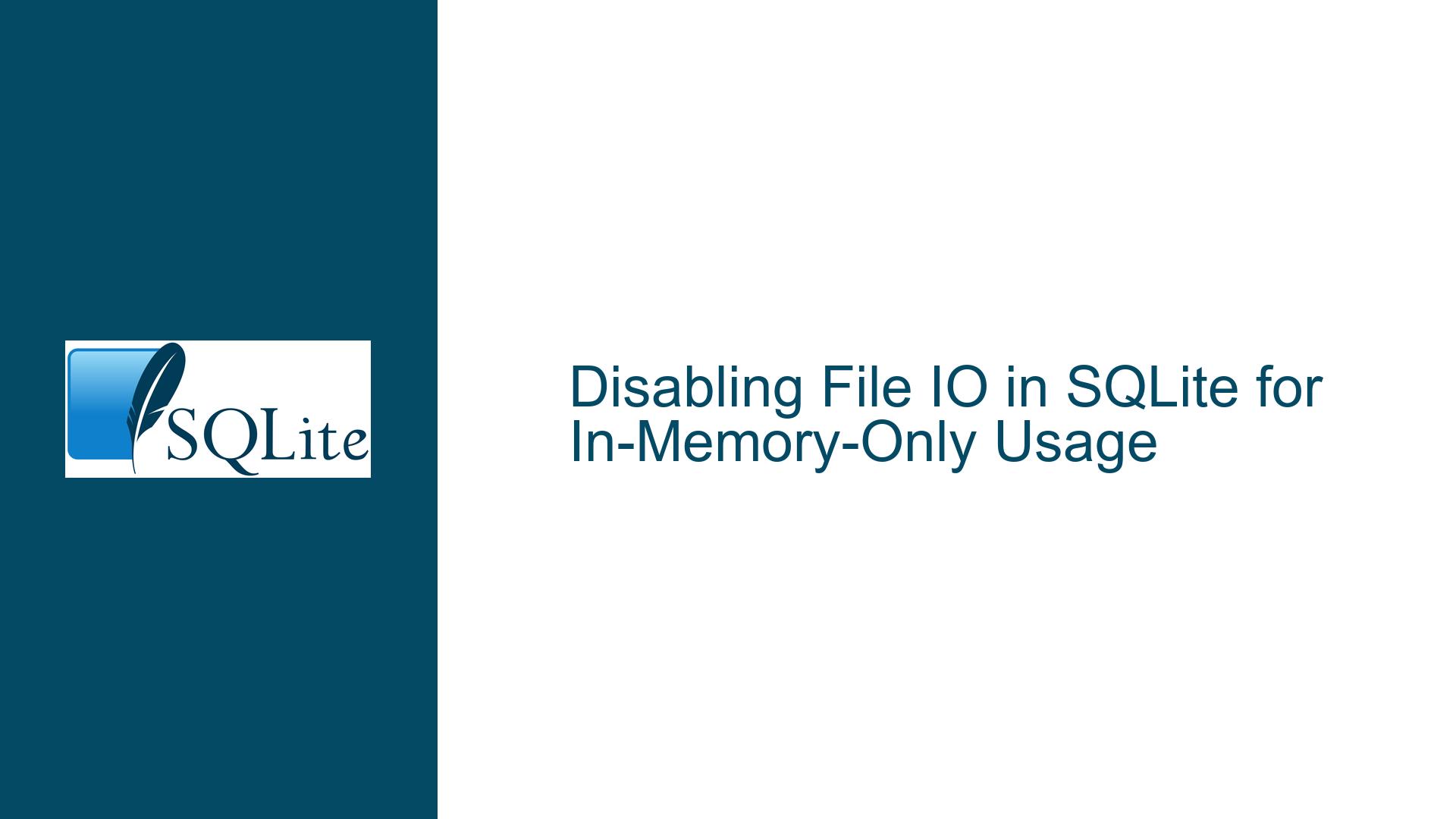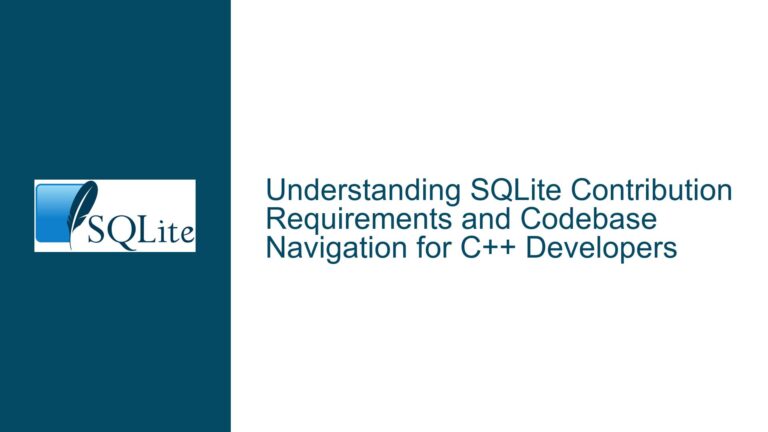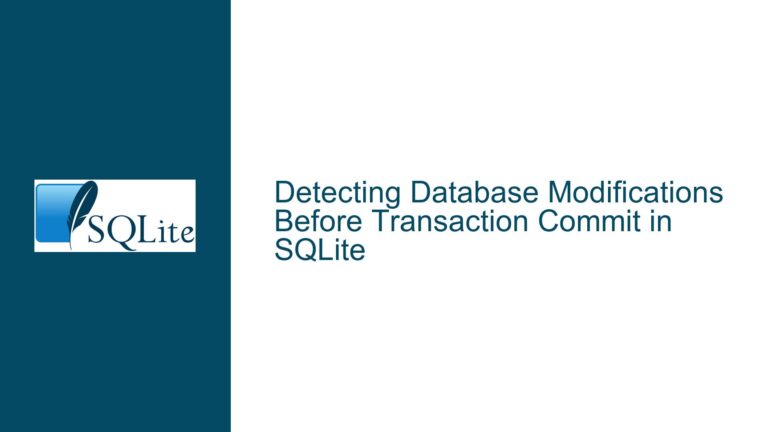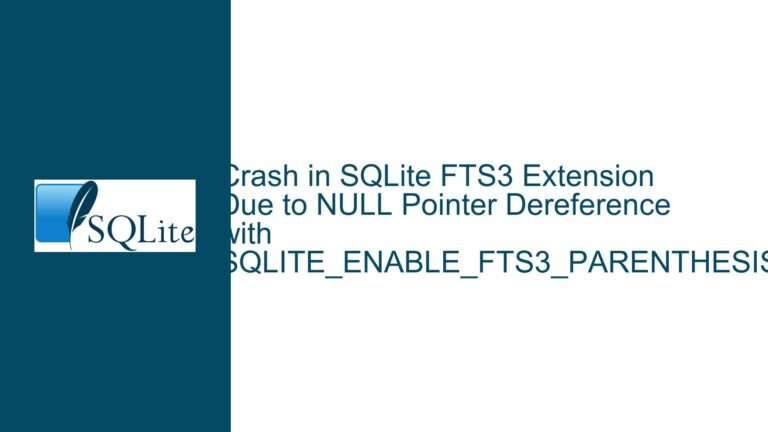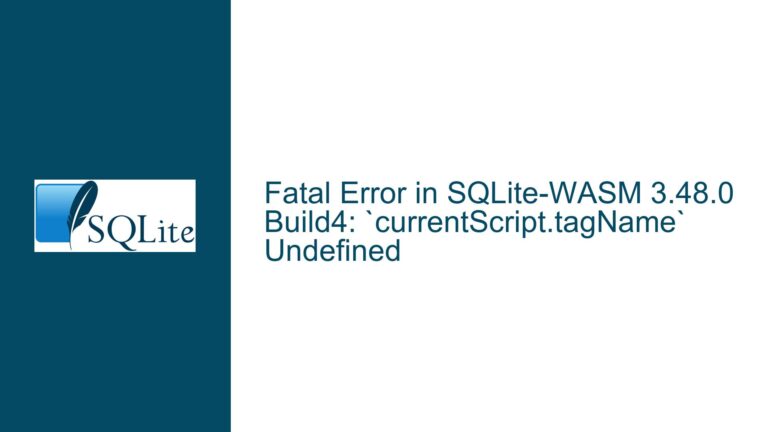Disabling File IO in SQLite for In-Memory-Only Usage
Understanding the Need to Disable File IO in SQLite
SQLite is a lightweight, serverless, and self-contained SQL database engine that is widely used in embedded systems, mobile applications, and other environments where simplicity and efficiency are paramount. One of SQLite’s key features is its ability to operate in both disk-based and in-memory modes. However, there are scenarios where developers may want to disable file IO entirely and restrict SQLite to in-memory operations only. This is particularly relevant when deploying SQLite on platforms that lack a traditional file system or where file IO operations are either unsupported or undesirable.
The primary motivation for disabling file IO is to ensure that the database operates exclusively in memory, eliminating any reliance on disk storage. This can be crucial for performance optimization, security, or compatibility reasons. For instance, in embedded systems with limited storage or in environments where file system access is restricted, disabling file IO ensures that SQLite functions within the constraints of the platform.
However, achieving this goal is not as straightforward as it might seem. SQLite’s architecture is designed to handle both disk-based and in-memory operations seamlessly, and disabling file IO requires careful consideration of the underlying mechanisms that enable these operations. The discussion highlights the challenges associated with disabling file IO, particularly the fact that the -DSQLITE_OMIT_DISKIO compile-time option, which was intended for this purpose, is no longer maintained and does not function as expected.
Exploring the Challenges with the SQLITE_OMIT_DISKIO Option
The -DSQLITE_OMIT_DISKIO compile-time option was introduced as a way to disable file IO in SQLite, effectively restricting the database to in-memory operations. When this option is enabled, SQLite is supposed to bypass all file system-related operations, ensuring that the database operates entirely in memory. However, as noted in the discussion, this option has not been maintained and no longer works as intended.
The primary issue with the -DSQLITE_OMIT_DISKIO option is that it was designed for an older version of SQLite and has not been updated to accommodate changes in the codebase. Over time, SQLite has evolved, with new features, optimizations, and architectural changes being introduced. These changes have rendered the -DSQLITE_OMIT_DISKIO option obsolete, as it no longer aligns with the current structure of the SQLite code.
Another challenge is that disabling file IO in SQLite is not a trivial task. SQLite’s architecture is deeply intertwined with file system operations, and many of its core components rely on the ability to read from and write to disk. Simply removing or bypassing these components can lead to unexpected behavior, crashes, or even data corruption. Therefore, any attempt to disable file IO must be approached with caution and a thorough understanding of SQLite’s internal workings.
Strategies for Disabling File IO in SQLite
Given the challenges associated with the -DSQLITE_OMIT_DISKIO option, developers seeking to disable file IO in SQLite must explore alternative strategies. One approach is to manually modify the SQLite source code to remove or bypass file system-related operations. This requires a deep understanding of the SQLite codebase and the ability to identify and isolate the components responsible for file IO.
The first step in this process is to analyze the SQLite source code and identify the functions and modules that handle file system operations. These include the VFS (Virtual File System) layer, which abstracts file system access, and the various functions that interact with the VFS to perform read and write operations. By carefully examining these components, developers can determine which parts of the code need to be modified or removed to disable file IO.
Once the relevant components have been identified, the next step is to modify the code to bypass or replace file system operations. This may involve replacing file-based functions with in-memory alternatives, or simply removing the code that performs file IO. However, this process must be done with care, as any errors or oversights can lead to instability or data loss.
Another strategy is to engage the SQLite development team to implement the necessary changes. As mentioned in the discussion, the SQLite developers may be able to provide custom solutions for disabling file IO, particularly for clients with specific requirements or budget constraints. This approach has the advantage of leveraging the expertise of the SQLite team, ensuring that the modifications are implemented correctly and efficiently.
In addition to modifying the SQLite source code, developers can also explore the use of custom VFS implementations. The VFS layer in SQLite is designed to be extensible, allowing developers to create custom implementations that replace the default file system behavior. By creating a custom VFS that operates entirely in memory, developers can effectively disable file IO without modifying the core SQLite code.
Creating a custom VFS involves implementing the necessary interfaces and functions to handle file operations in memory. This includes functions for opening, closing, reading, writing, and managing files, as well as handling transactions and other database operations. Once the custom VFS is implemented, it can be registered with SQLite, replacing the default file system behavior.
Best Practices for Disabling File IO in SQLite
When attempting to disable file IO in SQLite, it is important to follow best practices to ensure that the modifications are effective and do not introduce new issues. One key best practice is to thoroughly test any changes to the SQLite codebase. This includes running a comprehensive suite of tests to verify that the database operates correctly in memory and that no file system operations are being performed.
Another best practice is to document any modifications made to the SQLite source code. This includes keeping track of the changes made, the rationale behind them, and any potential side effects. Proper documentation ensures that the modifications can be understood and maintained by other developers, and it also provides a reference in case issues arise in the future.
It is also important to consider the performance implications of disabling file IO. While operating entirely in memory can improve performance in some cases, it can also lead to increased memory usage and potential bottlenecks. Developers should carefully monitor the performance of the modified SQLite database and optimize the code as needed to ensure that it meets the requirements of the target platform.
Finally, developers should be aware of the limitations of disabling file IO in SQLite. While it is possible to restrict SQLite to in-memory operations, this approach may not be suitable for all use cases. For example, in-memory databases are typically volatile, meaning that data is lost when the database is closed or the application terminates. Developers should carefully consider the trade-offs and ensure that disabling file IO aligns with the requirements of their application.
Conclusion
Disabling file IO in SQLite is a complex task that requires a deep understanding of the SQLite codebase and careful consideration of the implications. While the -DSQLITE_OMIT_DISKIO option was intended to facilitate this process, it is no longer maintained and does not function as expected. Developers seeking to disable file IO must explore alternative strategies, such as modifying the SQLite source code or creating custom VFS implementations.
By following best practices and thoroughly testing any modifications, developers can successfully disable file IO in SQLite and ensure that the database operates exclusively in memory. However, it is important to be aware of the limitations and trade-offs associated with this approach, and to carefully consider whether it aligns with the requirements of the target platform and application.
In conclusion, while disabling file IO in SQLite is not a straightforward task, it is achievable with the right approach and expertise. By understanding the challenges and exploring alternative strategies, developers can effectively restrict SQLite to in-memory operations and optimize the database for their specific use case.
